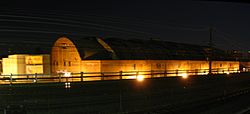Uline Ice Company Plant and Arena Complex | |
 Uline Arena in 2008 | |
| Location | 1132, 1140, and 1146 3rd St. NE, Washington, District of Columbia |
|---|---|
| Coordinates | 38°54′18″N 77°0′11″W / 38.90500°N 77.00306°W |
| Area | 3.9 acres (1.6 ha) |
| Built | 1941 |
| Architect | Kubitz & Koenig; et al. |
| Architectural style | Modern Movement |
| NRHP reference No. | 07000448[1] |
| Added to NRHP | May 17, 2007 |
 | |
| Tenants | |
|---|---|
| Hockey Washington Lions (AHL and EHL) (1941–1942, 1944–1949) Georgetown Hoyas (NCAA) (1941–1942, 1946–1949) GWU Colonials men's basketball (1941-1960) Washington Presidents (EHL) (1957–1960) Basketball Washington Capitols (BAA and NBA) (1946–1951) Georgetown Hoyas (NCAA) (1946–1947, 1949–1951) Washington Tapers (ABL) (1961–1962) Washington Caps (ABA) (1969–1970) |
The Uline Arena, later renamed the Washington Coliseum, was an indoor arena in Washington, D.C. located at 1132, 1140, and 1146 3rd Street, Northeast, Washington, D.C. It was the site of one of President Dwight D. Eisenhower's inaugural balls in 1953, the first concert by The Beatles in the United States in 1964, and several other memorable moments in sports, show business, politics and in the civil rights movement of the 1960s. It had a capacity of over 8,000 people and was a major event space in Washington until the early 1970s.
The arena was home to the Washington Capitols of the Basketball Association of America (1946–1949) and National Basketball Association (1949–1950), who were once coached by Red Auerbach. Later, the American Basketball Association's Washington Caps played there in 1969–1970.
Once abandoned and used as a parking facility, today it has been renovated and houses offices and the REI's D.C. flagship store.
It is directly adjacent to the railroad tracks heading into Union Station and bounded by L and M Street NE. It is located across from the Metrorail NoMa–Gallaudet U station southern entrance.
